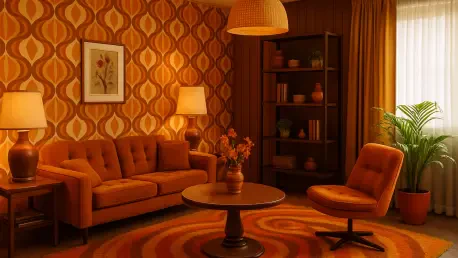As the world of interior design evolves in 2025, a striking shift is taking place, drawing inspiration from a decade known for its bold personality and inviting charm—the 1970s, in a resurgence that is not merely a nostalgic throwback but a thoughtful response to years of stark minimalism that left many spaces feeling cold and impersonal. Instead, the current trend leans into the warmth, texture, and character of that iconic era, reimagining it for today’s sophisticated tastes. Homes are becoming sanctuaries of comfort, filled with earthy tones, tactile materials, and curved forms that evoke a sense of lived-in luxury. This revival signals a cultural craving for environments that feel personal and grounded, pushing back against the sterile aesthetics that have long dominated. It’s a movement that celebrates individuality, encouraging design choices that resonate on a deeper, more sensory level, transforming spaces into havens of style and relaxation.
Rediscovering Retro Charm
A Shift Toward Sensory Appeal
The allure of 1970s-inspired design lies in its unapologetic focus on sensory experiences, a stark contrast to the muted palettes and sharp lines of recent trends. Homes today are embracing materials like smoked glass, burnished brass, and solid walnut, paired with soft fabrics such as boucle and velvet to create spaces that beg to be touched. Color palettes of ochre, rust, and olive dominate, bringing an earthy warmth that feels both nostalgic and fresh. This approach prioritizes comfort over clinical precision, with layered textures and handcrafted details adding depth to every corner. The result is an environment that feels inviting rather than intimidating, where every element contributes to a sense of ease. As design moves in this direction, the focus is on creating spaces that reflect personal stories, blending retro influences with modern craftsmanship to achieve a balance of style and soul.
Crafting Timeless Comfort
Beyond aesthetics, the revival of 1970s design speaks to a broader desire for timeless comfort in living spaces. Curved silhouettes, a hallmark of the era, soften the harsh edges of contemporary architecture, while modular furniture like velvet sofas offers flexibility without sacrificing elegance. Items such as leather-upholstered lounge chairs with sturdy oak frames provide enduring appeal, merging functionality with a relaxed vibe. This trend also emphasizes craftsmanship, with fluted detailing on sideboards and geometric patterns on rugs showcasing an appreciation for artisanal work. These elements are not just decorative but purposeful, encouraging a slower, more intentional approach to decorating. By incorporating such pieces, spaces become more than just visually appealing—they transform into retreats that nurture a sense of calm and connection, echoing the laid-back spirit of the decade while meeting the needs of modern life.
Blending Nostalgia with Modern Elegance
Textures That Tell a Story
One of the most compelling aspects of the 1970s design resurgence is the emphasis on textures that carry a narrative of their own. Materials like deep green marble in bowls or warm-hued cushions add layers of visual and tactile interest, turning everyday objects into focal points. These choices reflect a departure from the uniformity of minimalism, favoring instead a curated mix of organic and bold elements. A marble-topped coffee table with a geometric base, for instance, combines understated luxury with a retro edge, while an amber glass lamp casts a soft, mood-setting glow that harkens back to the era’s glamour. This focus on texture creates a dialogue between past and present, allowing homeowners to craft spaces that feel both familiar and innovative. It’s a design philosophy that values the imperfections and uniqueness of natural materials, ensuring that each room exudes personality and warmth in a way that feels effortlessly stylish.
Functional Design with Retro Flair
Functionality remains at the heart of this retro revival, with pieces designed to enhance daily life while embodying the charm of the 1970s. Think of olive-hued magazine racks that organize with flair or rust-toned geometric rugs that anchor a room with luxurious depth. These items are not mere decor but integral components of a lived-in space, blending practicality with aesthetic appeal. The era’s love for tactile craftsmanship shines through in every detail, from the sculptural forms of lighting fixtures to the soft curves of modular seating. This approach ensures that homes are not only beautiful but also adaptable, meeting the demands of contemporary living while paying homage to a bygone aesthetic. By integrating such elements, the design trend fosters environments that are both stylish and user-friendly, proving that nostalgia can coexist with innovation to create spaces that are as functional as they are visually captivating.
Reflecting on a Warm Legacy
Looking back, the resurgence of 1970s interior design stood as a powerful reminder of the value of warmth and individuality in shaping personal spaces. It marked a pivotal moment when the cold precision of minimalism gave way to a more soulful, tactile approach that prioritized comfort and character. Designers and homeowners alike turned to earthy tones, rich textures, and curved forms to craft environments that felt truly lived-in. This shift was not just about aesthetics but about reclaiming a sense of ease and connection within the home. As this trend unfolded, it became clear that the legacy of the decade offered timeless lessons in balancing style with substance. Moving forward, the challenge lies in continuing to adapt these principles, ensuring that future designs remain as inviting and personal as those inspired by this iconic era. Embracing small, thoughtful updates or experimenting with bold retro accents could keep this spirit alive, fostering spaces that resonate with both history and modernity.









